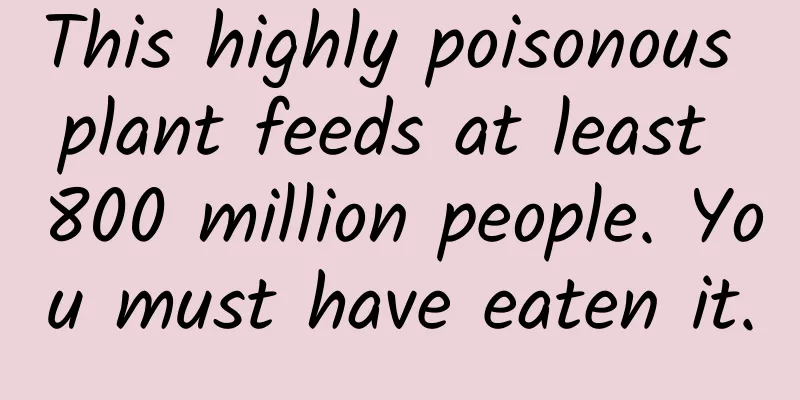This highly poisonous plant feeds at least 800 million people. You must have eaten it.

|
A 17th-century natural history painting of cassava by the Dutch painter Albert Eckhout Six people sat around a table with seven chairs. In front of the empty seat, there was a beautiful flower. A strange emotion filled the scene: no one would forget the night exactly one year ago when the beautiful girl's face suddenly twitched painfully and terribly, making it unrecognizable... This is the beginning of the novel "The Flash of Cyanide" by Agatha Christie, the "Queen of Detective Fiction". As a writer who is good at using poison to promote the development of detective novels, "Agatha" is particularly fond of cyanide . She used this poison to kill at least 18 characters in her books. In the novel, she truthfully described the symptoms of cyanide poisoning: painful convulsions, foaming at the mouth, and eventually suffocation. The cover of the American edition of "Flash of Cyanide" (Photo source: allergy.org) Cyanide is a substance with a slightly bitter almond smell (actually because bitter almonds contain cyanide), and only 50 to 200 mg is enough to kill an adult. For this reason, cyanide is a strictly controlled chemical. But there is a plant whose root tubers contain a large amount of cyanide, and a bite of it raw is enough to be fatal. However, it is the staple food for more than 800 million people, and is also the main raw material for many foods such as bubble tea, taro balls, vermicelli, noodles, potato chips, bread, and even laundry detergent and cat litter. This is cassava ( Manihot esculenta ). Cross section of cassava root tuber Cassava, also known as manioc, is a plant of the Euphorbiaceae family . If you have some knowledge of botany, you may know that cassava is not simple when you hear its origin in the Euphorbiaceae family. This family has two characteristics. One is that wounds on branches, stems and leaves easily ooze white juice; the other is that this plant family is famous for its " toxicity ". Rubber, castor, Chinese tallow tree, croton, lacquer, leprosy, wolfsbane euphorbia... none of them are easy to mess with. There is even a plant in this family that makes people terrified, the poisonous guava ( Hippomane mancinella ), which is one of the most toxic plants known to date. Manchineel, also known as horse-crazy euphorbia, is a tree plant of the Euphorbiaceae family, mainly distributed in Florida, the United States, and Central and South America. The leaves of this plant have a lot of burrs, which release alkaloids once they come into contact with the skin, causing long-term pain to the human body. Even hiding under the tree from the rain may be dangerous. As a "disciple of Tang Sect", cassava also adopts the same strategy: its whole body is rich in cyanogenic glycosides and various alkaloids. If people accidentally eat fresh cassava tubers, these substances will come into contact with stomach acid to form highly toxic hydrogen cyanide . If it were an ordinary plant, eating it would be so risky, and humans would naturally stay away from it, and it would not have any impact on human history. But cassava stores energy in the form of starch in its tubers, which makes humans look at it differently. The taproot and main lateral roots of cassava will swell and grow, just like a wooden root with "radishes" growing underneath (Photo credit: davinehawaii.com) Cassava originated in the southern edge of the Amazon Basin in South America . Indians had already started eating cassava at least four thousand years ago. Before Columbus arrived in America, cassava was already widely planted in America. With the great exchange of species between the New and Old Worlds, cassava was widely planted in Africa, Asia, and Oceania after the 15th century. Cassava not only has a high starch content, but is also drought-resistant, has a short growth period, is suitable for growing in various soils, and has a high yield. This has quickly adapted it to the matching mechanism of the African region. Today, Nigeria has surpassed Brazil, the origin of cassava, to become the world's largest cassava producer. The yield of cassava per mu can reach an astonishing 6 tons, and the energy produced per unit area of land by planting cassava is much higher than that of rice, corn and wheat. Therefore, it is a food crop that many developing countries rely on for survival (Photo source: davinehawaii.com) Cassava has played the role of a "lifesaver" many times in human history. For example, during the great famine in southern India in 1880 or the food shortage in Venezuela in 2010, cassava was one of the few foods that could fill the stomachs of local people. In many areas where wheat, corn or rice cannot be grown at all, cassava is the only crop that can provide starch . Therefore, in the legends of many ethnic groups, cassava is a gift from God. Of course, smart humans have also thought of various ways to deal with the toxicity of cassava: the traditional method in South America is to soak cassava repeatedly for 18 to 24 hours, then grind it into water starch for consumption. The local Makushi people also use cassava to make an alcoholic beverage called Parakari; the Lucayan people of the Bahamas put cassava in special baskets, mash it and boil it before eating; the West African method is to peel the tubers and ferment them in water for three days, using microorganisms to remove cyanide; the Vanuatu people in Oceania roast cassava and make pudding with native plants. Parakari made from cassava (Photo credit: Visit Guyana@Facebook) On the other hand, after continuous screening and cultivation, cassava has also produced two strains: sweet cassava with lower cyanide content and bitter cassava with higher content. Sweet cassava has a relatively low yield, but the risk of poisoning is also low, and it can be eaten after peeling and cooking; bitter cassava has a high yield and is more suitable for growing in harsh environments, but it must be processed before it can be eaten. Now, one of the research ideas for cassava is whether it is possible to combine the characteristics of the two types of cassava to continuously increase cassava production while reducing cyanide. In the early 19th century, cassava was introduced to the southern coastal areas of mainland China, mainly in Guangdong, Fujian and Taiwan. However, the planting area of cassava in my country has always been limited. Except for being used to save lives in disaster years, it has not been very popular most of the time. However, in recent years, with the rise of the milk tea industry , cassava has also played a greater role. Cassava has more branched starch, so it tastes more like glutinous rice. The pearls, taro balls, puddings, tapioca and grass jelly in milk tea are basically made of cassava starch. "We all have a mother, her name is Cassava" (Photo source: Internet) In addition, cassava starch can also be used to make feed, alcohol, glucose, plastic fiber, paint, etc. Because the price is lower than other starches, although we rarely see fresh cassava tubers, cassava has already been used in all aspects of our lives. It is also very common to use tapioca starch to make vermicelli or noodles. Because the particles of tapioca starch are smaller than other plant starches, the taste is even better. In fact, most of the local specialties that are proud of nowadays, those vermicelli with good appearance and elasticity, will add tapioca starch. This is not only for cost considerations, but also for a better taste. Vermicelli and rice noodles. According to the current quality regulations for starch products in my country, there is no restriction on the use of cassava, and ordinary people in my country do not need to worry about the cyanide problem of cassava. Because cassava in its original form is almost impossible to buy in the Chinese market (Photo source: Guangxi Food Industry Association) As a plant, cassava itself may not have thought that even though it has evolved into a highly poisonous form, it still cannot escape the influence of humans on its fate. However, many of the "stigmas" are not the problem of cassava itself, but humans have poured the dirty water of stupidity and lies on cassava in the name of sincerity. References [1] Christie, Agatha. Flash of Cyanide[M]. Commercial Press, 2016. [2] Catherine Huckappa. Agatha's Poison[M]. Lijiang Publishing House, 2017. [3] Liu Jia, Zhang Jian. Introduction and promotion of American cassava in Africa[J]. World Agriculture, 2019(2):7. DOI:CNKI:SUN:SJNY.0.2019-02-015. [4] Zhang Jian. A preliminary study on the development history of cassava[J]. Chinese Agricultural History, 2011, 30(2):12. DOI:CNKI:SUN:ZGNS.0.2011-02-001. [5] Zhuoke Technology Reference 3 (Annual Daily Update) 306|Misunderstanding: Cassava Starch vs. Sweet Potato Starchhttps://www.dedao.cn/share/packet?packetId=Rjyo573qaAYw3DEc3jEViR2zrM0BmXD6&uid=0QvaT-QiavKR3rITgMaLbQ&trace=eyJzX3BpZCI6IjExMTM4NSIsInNfcHR5cGUiOiI2NSIsInNfdWlkIjoxMzQ0NzI2fQ%3D%3D [6] Daly, Lewis (2019) The Nature of Sweetness: An Indigenous Fermentation Complex in Amazonian Guyana. In K. Hockings and R. Dunbar (eds.), Alcohol and Humans: A Long and Social Affair. Pp. 130–146. Oxford: Oxford University Press. [7] Nweke, Felix I. (2005). »The cassava transformation in Africa«. A review of cassava in Africa with country case studies on Nigeria, Ghana, the United Republic of Tanzania, Uganda and Benin. Proceedings of the Validation Forum on the Global Cassava Development Strategy. Vol. 2. Rome: The Food and Agriculture Organization of the United Nations. [8] Save and Grow: Cassava (PDF). Rome: Food and Agriculture Organization. 2013. p. iii. ISBN 978-92-5-107641-5. Retrieved 27 October 2016. Planning and production Source: Bring Science Home (ID: steamforkids) Author: Quasimodo by the River Editor: He Tong Proofread by Xu Lai and Lin Lin The cover image and the images in this article are from the copyright library Reprinting may lead to copyright disputes |
>>: More terrible than PUA! What does the popular "NPD" mean?
Recommend
Kuaishou short video advertising platform gameplay + case introduction!
Kuaishou is a well-known short video application ...
Why do I see strange patterns when I rub my eyes?
Long working or studying time People's eyes a...
CATL financial report: CATL's revenue for the full year of 2024 is 362.012 billion yuan, down 9.70% year-on-year
According to recent news, CATL released its 2024 ...
How does Juliang Qianchuan invest in live streaming?
There are two ways to promote Juliang Qianchuan’s...
Event Operations: How to conceive event ideas?
I once had a colleague who switched from another ...
Mobile phone user loyalty rankings released, Apple is No. 1! But is it the top retention rate?
Mobile phones have become an indispensable part o...
The sun is becoming increasingly "violent", how can spacecraft "defend themselves"?
Recently, there is news that due to the intensifi...
Why do weasels fart? This is their secret weapon
Many people have had various "encounters&quo...
Yogurt really helps digestion! But it's not what you think...
Have you seen the news recently about a certain b...
You need to be aware of these trends in self-media advertising in 2017
The self-media industry is already on the eve of ...
Drink bone soup to supplement calcium? This article tells you how effective it is
Can bone soup provide calcium? The calcium in bon...
iPhone travel notes: From production workshop to retail store
Beijing time, December 29th, according to foreign...
Tragedy repeats itself: Why do video content service providers always lose money instead of making any profit?
After the domestic video website company Youku Tu...
Is “use it and leave it” outdated? Lessons from the Battle Between Two Giants of Android Optimization Tools
Zhang Xiaolong said in a public speech last year ...









